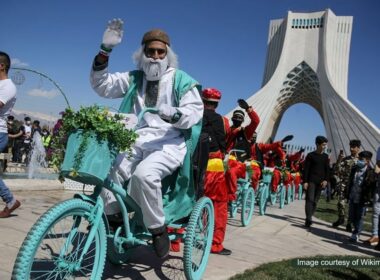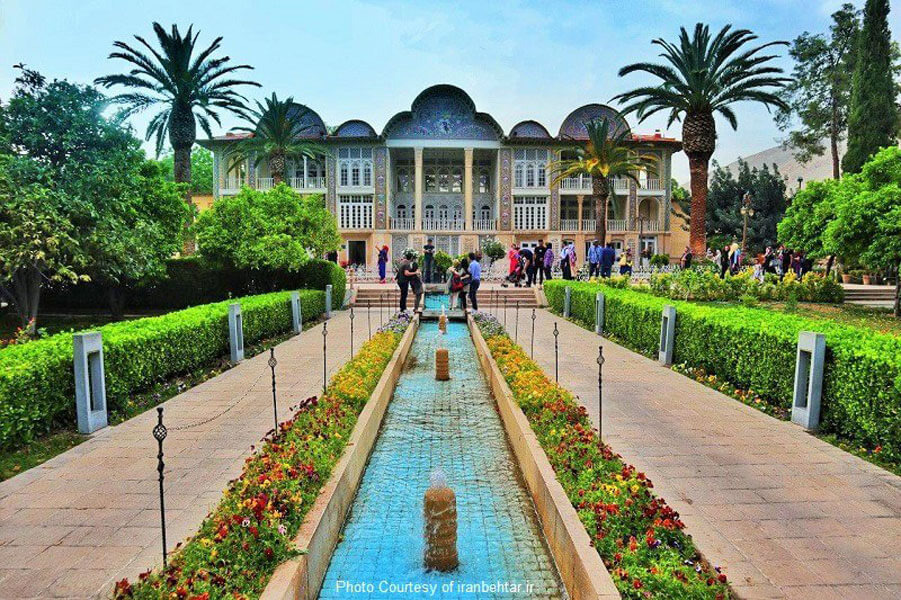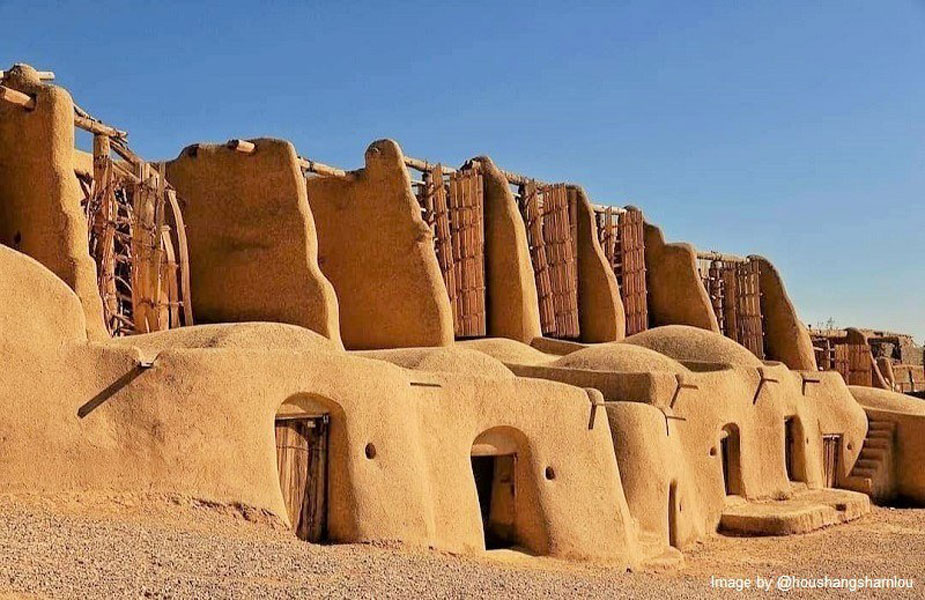
The use of potential energies of nature in the native architecture of Iran has got a long history. For the first time in the eastern regions of Iran (South Khorasan and North Sistan and Baluchestan provinces), people used the aerodynamic force of the wind. The ancient windmills of Iran are one of the technical and architectural achievements of Iranians in wind usage.
The 120-day wind of Sistan is still used to grind grains in windmills. Due to the lack of water, windmills (Aasbaads) have taken the place of water mills in this area.
Today, sustainable development is one of the hottest topics in the world. Proper use of climate and environmental conditions is one of the sustainable development approaches. The use of renewable energies is well seen in the native architecture of Iran, especially the old palaces of Iran in Sistan. This creativity is one of the technical achievements and traditional Iranian architecture.
Aasbaads have played a vital role in people’s lives in the past. Today, with the expansion of industry and technology, they have lost popularity, but there are very valuable technical and architectural achievements in Iran’s Aasbaads.
The ancient windmills of Iran are the oldest vertical windmills in the world. According to historical documents, these structures have been one of the main pillars of durability and sustainability of life in eastern Iran. The use of organic materials and the clean energy of the wind can be seen in Aasbaads.
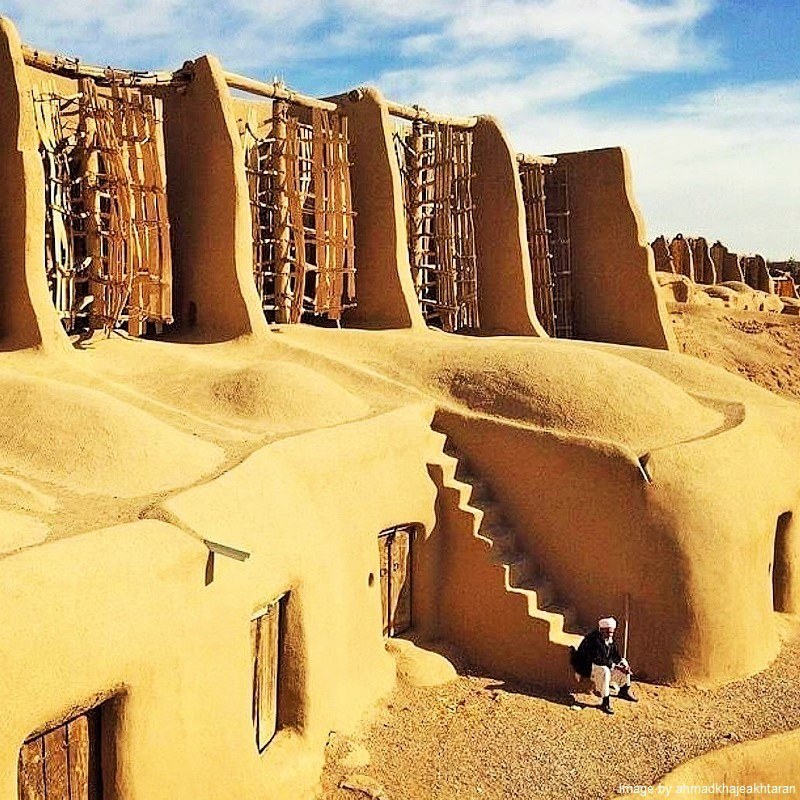
These buildings have a useful function and are beautiful at the same time. They are also divided into several categories in terms of species and have their own variety and extent.
The History of the Ancient Windmills of Iran
The history of these wind structures is believed to be 1300 years ago. The first wind building in the world belongs to the 7th century AD in Sistan, Iran. These structures were built in the ancient village of Nashtifan, Khaf, as the technical and architectural achievements of that region. They had between six and twelve blades, which were covered with cloth or palm leaves.
Their use has been grinding edible seeds or rinsing. Also, in Sistan and near the burned city of Zabul, there are remains of the earliest ancient windmills of Iran. Even today in the city of Zabul, there is a neighborhood called Aasbaad.
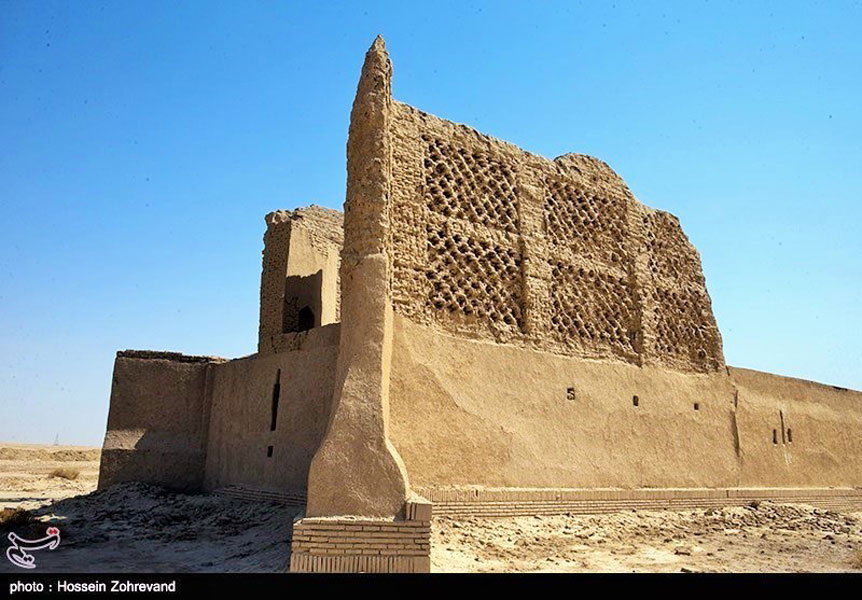
In the book of Istakhari (before 941 AD), the construction of Aasbaads is mentioned. Also, in one of Mas’udi’s books (about 947 AD), there is a story in which Aasbaads are mentioned.
Historians refer to the story of the killing of the Sassanid king, Yazdgerd, by a miller which is another proof of the antiquity of Iran’s ancient windmills. Referring to the killing of Iranians in Elis under the command of Khalid also shows that Aasbaads existed in Iran since ancient times. There are stories that there were watermills and windmills in Gorgan during the Umayyad period.
In the book Matikan-e Sistan, it is stated that one of the industries of Sistan is wind turbines. Arab geographers have mentioned these structures too. When the Arabs entered Sistan, the only thing that surprised them was the ancient windmills of Iran.
Encyclopedia Britannica states that after the invasion of the Mongols, the Persian prisoners of war were taken beyond the eastern borders.
In the book “Cities called “Iran during the Parthian and Sassanian Eras”, it is mentioned some big cities had mills in those days. Also, there have been codified rules for the use of the mill, the wages of the miller, and the rent of the mill. Sistan is mentioned several times in this book.
The Etymology of the Word Aasbaad
The word Aas alone means stone and Aasbaad means a stone that rotates with wind energy. “Aas Aab” or watermill means a stone that rotates with the energy of water. “Aas Dast” means a stone that rotates with the power of the hand.
The Origins of Windmills in Iran
These ancient wind structures of Iran can be seen in the cities of Nehbandan, Khaf, Nishtifan, Khargerd, Barabad, etc. Among these, only the collection of Nashtifan Aasbaads has survived for many years and some of them still maintain their operational status. The remains of this invention can be seen in the historical site and the ancient site of Rostam Hozdar Castle (Qalcheh) near Shahr-e Sukhte and other areas of Sistan.
A handful of ancient windmills of Iran are used symbolically to produce flour in a traditional way. Many of them are subject to natural damage and are being destroyed. The ancient Iranian windmills should be given more attention as the technical and architectural achievements of that region.
Aasbaads of Tabas Messina is built on the edge of the desert on two floors. These structures, in addition to a place to place Aasbaad stone, also have a part for storing wheat and flour. The Aasbaads of this area belong to the Qajar period.
The Causes of the Construction and Formation of Aasbaads
The vital need of the people for flour and semolina was the reason for the emergence of this technical and architectural achievement. Due to the growth and concentration of the population in Sistan and the other neighboring cities, it was not possible to use animal and manual mills. Also, with the development of agriculture and the increase of agricultural products in this region, Aasbaads became widespread.
In those years, Sistan was known as the granary of Iran. Therefore, there was a need to a stronger source of energy beyond human possibilities, such as humans and animals. The power of the ancient windmills of Iran was tapped to help humans to mechanically and continuously transform grains into flour and bulgur.
These structures turned grain into flour, bran, and semolina 24 hours a day and seven days a week. This provided a stable income and the dependence of other territories on this invention. In a way, Iran’s traditional Aasbaads can be referred to as oil refineries and modern power plants, including hydro, wind, solar, nuclear, fossil, and hybrid. In fact, ancient windmills of Iran are the ancestors of today’s wind generators.
Technical and Engineering Structure of the Ancient Windmills of Iran
The way these structures are formed is very interesting and surprising. They are made with very simple materials such as wood and mud. Therefore, they are among the valuable technical and architectural achievements of Iran.
Wind turbines convert moving kinetic energy (wind) into other forms of energy. Therefore, it can be said that a wind turbine is a motor that is driven by wind power to convert wind energy into the desired form.
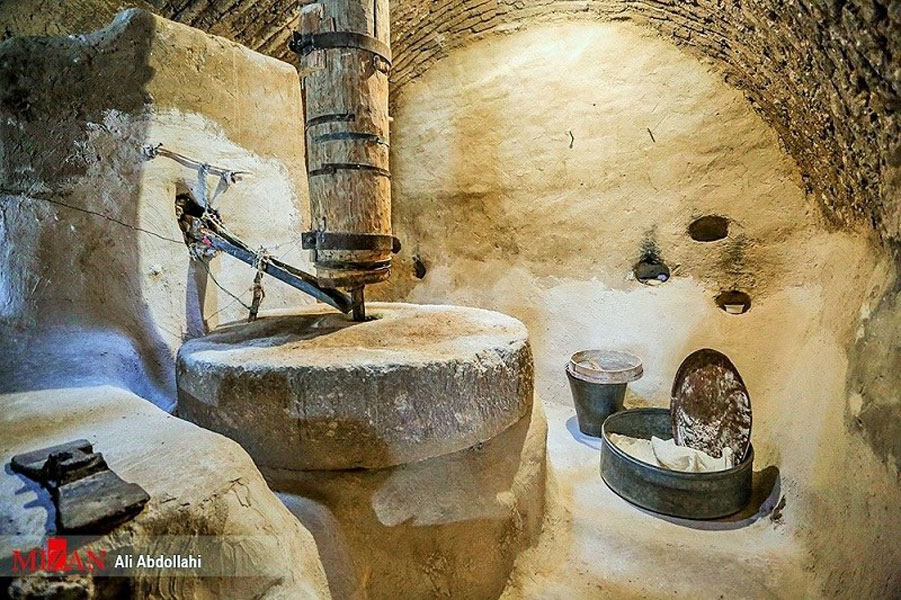
The building of ancient Iranian windmills consists of two main floors. The ground floor, which is considered the main hall of the structure, is the location of the large and circular stone of the mill. This part is called “Aas Khaneh”. Grain-crushing activity is done here. This floor is also used as a grain store. Attention to performance is considered one of the technical and architectural achievements in Iran.
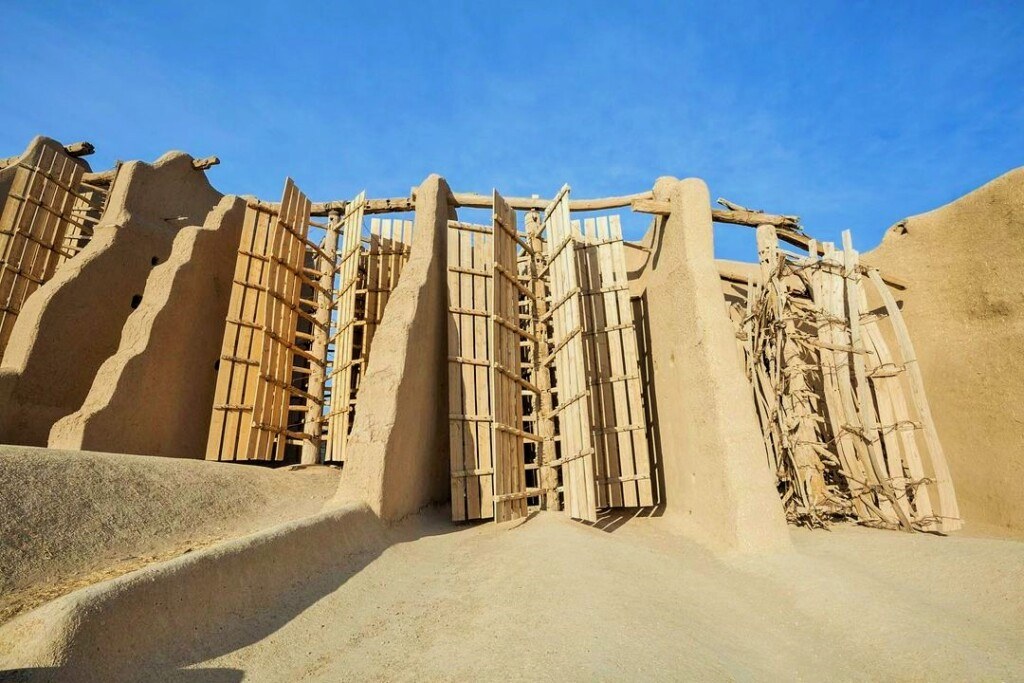
On the second floor, which is considered the roof of Aasbaad, there are beams and poles connected to it. This part is called “Parreh Khana”. The blades of the mill are made of wood. These vanes are light enough to move easily and can move the large rock below. In more tropical regions, the vanes are made of different materials.
The 120-day winds of Sistan are the most famous local winds in Iran. These winds blow from the middle of June to the beginning of October in a wide area of the eastern regions of Iran. The winds enter the blades of these ancient Iranian Aasbaads and move them.
The people of South Khorasan call this type of wind “Siahbaad” or “Baadkuh”. The characteristic of these winds is high continuity, speed, and proper time. The high speed of these winds sometimes reaches 120 kilometers per hour.
Components of the Ancient Windmills of Iran
The building of ancient windmills of Iran was built on a hill without any foundation. Therefore, the materials used in the foundation of the building are the same as the ground. To build the walls of an Aasbaad, mud bricks are placed on top of each other. Of course, in some of the Aasbaads left from the old days of Iran, such a clay wall was built as high as the arch was to start.
- Millstones consist of two wide cylindrical stones. The top stone, which turns on the bottom stone while working, has a hole in the middle, and the wheat enters through this hole and exits through the gap between the two stones around.
- A bridge is a branch that becomes flat by installing foliage on it.
- A Kharpol above the Mill is a column made of pine wood with a diameter of 30 cm and a length of 5 meters. Its two ends connect horizontally on the side walls of the mill. It is connected to the mill with a wooden axis in the middle. In the middle of this truss, there is a hole where the vertical axis of the wheel and blade is connected to the horizontal truss. A wooden lever facilitates the movement of the axis inside the cavity, and the function of the truss is to prevent lateral movements.
- The transformation piece lands from the second part of the mill on the face of the stone and sets it in motion. This piece is 8 meters long and 35 in diameter and 101 cm thick.
- The Arm or Bahu are wooden levers with a length of 115 cm and a diameter of 7 cm. One of their ends is connected to the blades and the other to the transformation piece. In fact, they are the interface between them. They transfer the rotational force of the blades which is caused by the wind to the transformation piece and cause the rotation. Each blade has 6 to 7 arms.
- The Vane is is a lever made of wood, 14 cm wide and 1 cm thick, and approximately 1 meter long. The number of vanes in each group is 4 or 5.
- The Ney Baad (wind reed) is a tool that adjusts the intensity of the wind passing through the openings. This part is woven like a mat. It functions when they want to stop the Aasbaads or change their circulation speed.
- The distance between the arms is called Dargah (opening), which is usually about 62 cm.
- A Metal Tureh is a metal rod with a length of 36 to 50 cm, the width of which is 6 to 7 cm in the narrowest part and 10 to 12 cm in the widest part. Also, its diameter is 2 to 12 cm. It is installed at the end of the transformation piece and is bifurcated at the end.
- A Bifurcated Lever is a lever made of wood with a height of 140 cm, the end of which is bifurcated.
- A Moshteh lever is a strong, conical wooden lever with a height of 40 to 50 cm and a diameter of 3 to 4 cm in the narrowest part.
All components of ancient windmills of Iran are considered indigenous technology and architectural achievements.
The Evolutionary Course of Ancient Iran’s Windmills
Windmill structures are available in different types. Aasbaads, which are designed in rural areas and with simple shapes, are called basic simple types. The types that have larger and more complex structures are considered more evolved types of Aasbaads. These types of Aasbaads are called Dalani.
Basic Simple Aasbaads
Today, the ancient windmills of Iran can be seen in the village of Nishtifan or the mills of Khan Sharaf near Nehbandan. They consist of a two-story building designed with raw clay materials on two floors with a simple square plan.
These simple buildings have little functional capacity. It is also possible to build them easily for the farmers. Each of them belongs to a family. They are also not considered public buildings. On the other hand, in a region, usually, one point is the most suitable spot to build an Aasbaad.
Therefore, such ancient Iranian windmills are formed near the mentioned point. According to an unwritten rule, the residents do not build anything in front of these buildings where the wind enters them so that the Aasbaads work at their maximum capacity.
As a result, groups of these Aasbaads are usually seen side by side, creating a distinctive landscape and skyline. The Aasbaads that exist today in Nishtifan and Khan Sharaf has recently been restored and are estimated to date back to the Safavid era.
These structures are the remnants of a large group of windmills that were spread in all the villages of eastern Sistan and Khorasan today.
Dalani Windmills
The most complete and beautiful type of windmills that are available in Sistan today are Aasbaads which are individually designed and built. These structures are much bigger than simple Aasbaads and have beautiful brickwork. Also, they are made up of two floors.
The upper floor is the place for the mill vanes and the lower floor is the place for the stone. But the wind inlet has become an open corridor. This duct starts with a large opening with side vanes, which is responsible for collecting wind.
Then the wind enters the inner part through two or three slits located on one side of the wall of this corridor, where the vanes are located. In other words, the gap leads the wind to the front of the vane.
Visiting the Ancient Windmills of Iran
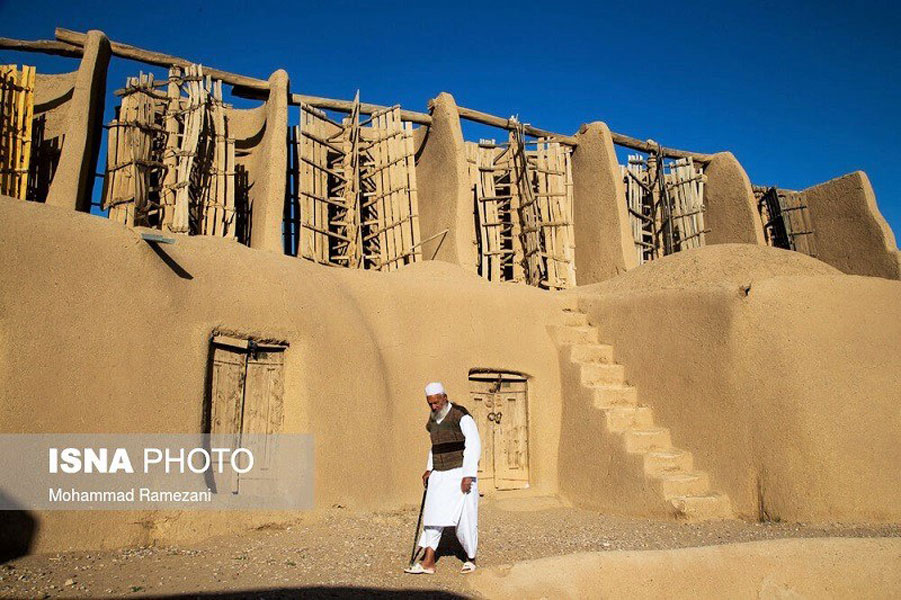
Aasbaads were formed hundreds of years ago when Sistan had a unique boom in agriculture. This building was able to continue its activity for centuries using renewable and natural energy.
Nowadays that the topic of energy has become very important, it is possible to use the technical and architectural achievements of Iranians in this field. By studying and investigating the way this building is formed, it is possible to design and implement systems that are compatible with nature.
By visiting the ancient windmills of Iran in South Khorasan and North Sistan and Baluchestan provinces, you can see the coexistence of man and nature. Destination Iran recommends taking a trip to this part of Iran. Whether you personally travel to the east of Iran or in the form of Iran tour packages, you must explore these historical monuments left by the wise ancestors of the people living at this part of Iran.



